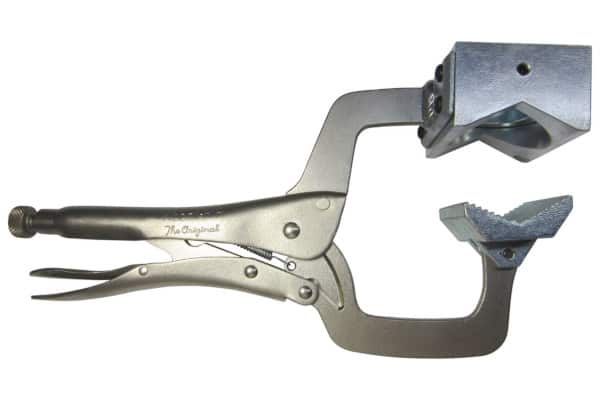Paired with sharp blades and a series of hole-saw guides, this simple grip immunizes pipefitters against some dangerous slips and costly errors
The pilot clamp is just one of many tools designed to make pipefitters’ lives easier—and it’s also one of the most popular. These locking hole-saw guides help plumbers, fire protection contractors, and other people drill even, level holes in metal pipe. To learn more about the uses and benefits of these tools, read on.
If you’d like to skip directly to our selection of pipefitting tools, view our collection of complete pilot clamp kits, hole-saws, replacement hole-saw guides, and pilot clamp replacement parts, or alternatives like the Tru-Drill II portable hole-saw cutting machine.
When using a drill press isn’t convenient or practical, pilot clamps provide an alternative way to drill holes in metal and plastic pipes
The pilot clamp is one of the most beloved tools for consistent pipe fitting—in the field or in the shop. They’re such a popular choice, in fact, that suppliers can’t always keep up with demand.
The reason is simple: without tools designed to drill holes in metal or plastic pipe, establishing and maintaining accurate drill positioning can be tough. Typically, the challenge lies in getting the teeth of a saw to catch the surface of a pipe evenly. There are some things that can make this process easier: fabricating pipes in the shop, for example, where a full-scale drill press may be used. Lubricating hole-saws with cutting oil can reduce friction, keeping the blade sharper and cleaner when drilling without a guide. But in confined spaces, or in situations where only minimal leverage is available, using a drill press may not be an option—and free-hand drilling may not deliver the desired results.
Pilot clamps provide a portable, yet surprisingly accurate, a hole-saw guiding system. At the heart of each is a specialized set of locking pliers. These pliers accommodate a variety of guide bushings, known as hole-saw guides, that help installers penetrate thick pipes with a portable drill.
Operators lock this tool into position by squeezing two handles together. After that, the pilot clamp requires no additional steps to remain firmly in place. Users can focus on positioning themselves for maximum leverage and control, all while the guide keeps the blade aligned until drilling is complete.
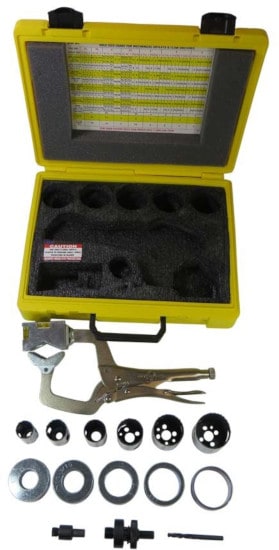
Interchangeable parts provide contractors with flexibility during installation and guarantee the longevity of each clamp
A pilot clamp has several interchangeable components. These parts can be removed and replaced to extend the life of the clamp. They also allow pipefitters to make holes of various sizes in pipes with a range of thicknesses.
Essential components: pliers, jaws, and heads
- Adjustable locking pliers. Often known by the Black & Decker brand-name “Vise-Grip,” these tools open when users squeeze a lever mounted inside one handle. A wheel at one end adjusts the width between the plier’s jaws while compressing the handles locks it in place.
- The (lower) jaw. In conjunction with the clamp’s head, this ridged metal component provides a secure grip. The jaw curves to fit cylinders of various sizes, using “teeth” to prevent slippage.
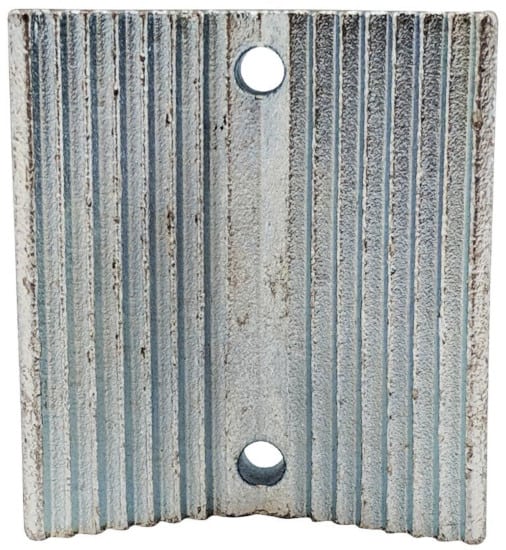
- The clamp head (or upper jaw). Home to hole-saw guides of various sizes, this part features a V-shaped lower surface that wraps around a pipe. Horizontal and vertical bubble levels help contractors select the angle desired.
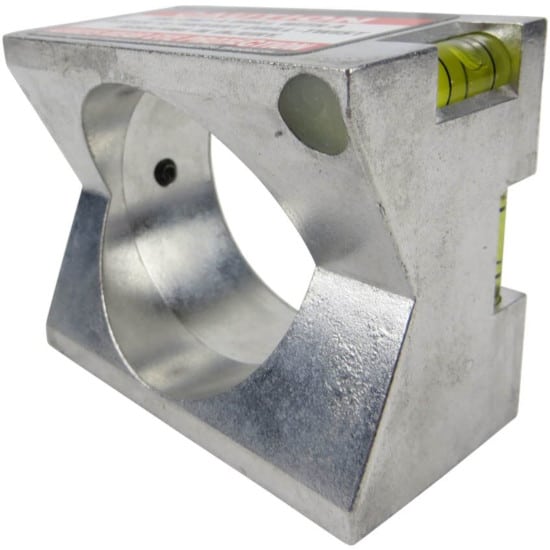
Interchangeable parts: guides, blades, and arbors
- Hole-saw guides. Standard sizes for these small, cylindrical guides accommodate blades from 1″ to 2″ in diameter. Each has an inner diameter sized for a saw blade and an outer diameter designed for a snug fit inside the clamp head. A small slot on one side allows users to remove the guide with a flat-head screwdriver.
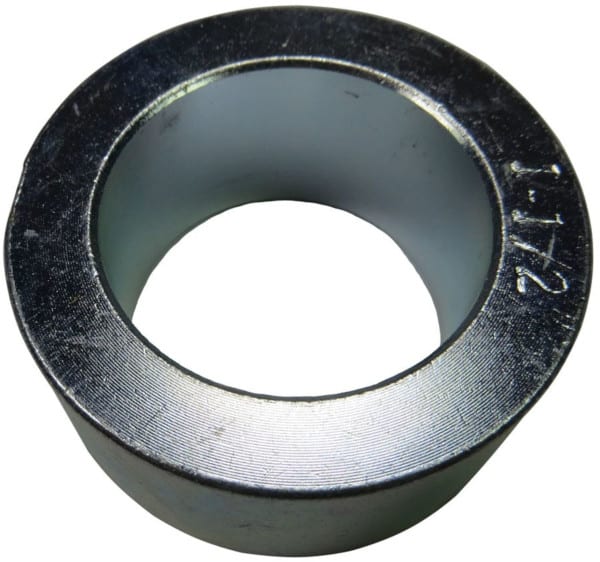
- Hole-saw blades. Each blade is complemented by a hole-saw guide that allows it to contact a pipe’s surface at a fixed angle. It can safely drill to a specified depth in materials that range from non-ferrous metal and stainless steel to PVC and CPVC. The number of teeth per inch (TPI) on these blades determines the speed and smoothness of the cut. In general, blades with higher TPI are better suited to thinner materials, while lower-TPI blades cut thicker materials (quickly).
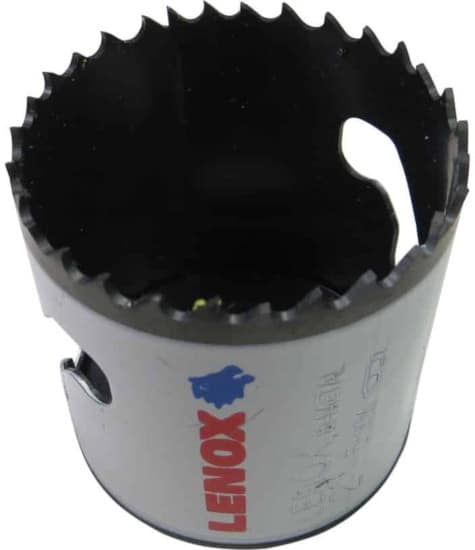
- Arbors. Also known as a “pilot drill bit,” an arbor helps to center the saw’s blade by drilling a small hole in the center of the material being cut. The drill secures to the arbor’s shank, which, in turn, holds the hole-saw in place.
As a last-minute fix or a permanent solution, locking hole-saw guides help make joining pipes or installing select fittings easier and faster
Skilled pipefitters have countless tricks to drill clean holes in metal pipe. Some file down a flat surface on the pipe before drilling. Others assemble makeshift drill bushings, block-and-clamp sets, or jigs. Some of these approaches can drill a hole that’s straight (or “straight enough”).
But for greater accuracy—particularly when drilling a series of parallel or perpendicular holes across a single pipe that’s already installed—it’s hard to beat a pilot clamp. By centering the vertical or horizontal bubble levels on the clamp head, installers can guarantee that holes remain consistent across the length of an entire pipe.
Watch below as an installer drills from start to finish in just one minute (including positioning time):
The applications are numerous. Buildings both commercial and residential rely on piping systems for fire protection, sewage removal, and potable water delivery. Each consists of an interconnected series of pipes made from steel, copper, iron, or plastic materials.
For the most part, contractors prefabricate pipes with the holes needed in the shop. In the original patent filed more than two decades ago, inventor Michael S. Cooper explained that there are instances where it’s hard to predict where those holes belong. In fire sprinkler systems, locations for pipe runs—particularly branch lines added to an existing system—may not be easy to predetermine. In short, modifying these pipes in the field—before or after they’re installed—may be far more practical than moving a heavy, full-sized drill press to the job site.
For more, QRFS encourages readers to see “How to Use a Pilot Clamp in 6 Easy Steps.”
What to look for in a pilot clamp?
Since their invention, every one of these hole-saw guide clamps has sought to:
- Prevent slipping or jerking from uneven cuts
- Place holes in the exact location desired
- Reduce the use of heavy machinery
- Make retrofit piping operations possible
A good pilot clamp, then, rigidly attaches to pipes—and removes quickly afterward. Bushings must fit saw blades with the size and sharpness required, and counteract forces that lead to drift or jerking. Portability, versatile positioning, and compatibility with a variety of rotary drills are all essential.
One product meets all of these criteria: the complete pilot clamp kit. Buildings can have pipes of all shapes and sizes. As such, these kits feature several interchangeable hole-saw guides—in 1″, 1-3/16″, 1-1/4″, 1-1/2″, 1-3/4″, and 2″ sizes—with compatible hole-saw blades and arbors. Manufactured in Massachusetts by Lenox, these “bi-metal” blades feature a slot that allows contractors to quickly remove cut material from the blade’s center. These and other components are stored together in a padded carrying case complete with a hole size guide.
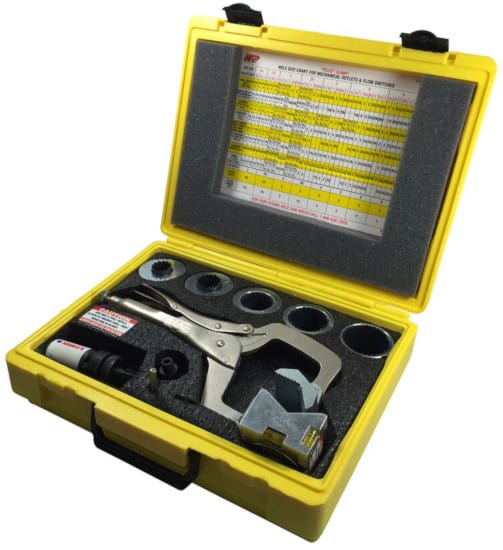
QRFS also stocks a supply of replacement parts designed to extend the life of each kit, including:
By pairing a pilot clamp with a hand-held drill, nearly any user can consistently produce professional cuts perfect for use with mechanical tees and a variety of other joining methods.
View specifications for QRFS’s complete pilot clamp kit.
This blog was originally posted by Jason Hugo and Cameron Sharp at blog.qrfs.com on June 10, 2016, and updated on October 4, 2019. If you like what you’ve read, check us out at Facebook.com/QuickResponseFireSupply or at Twitter @QuickRsponseFS.


